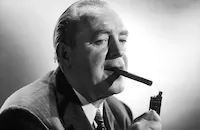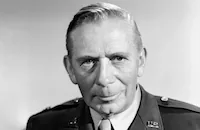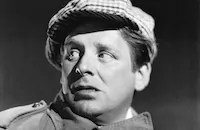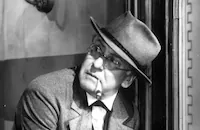Crack-Up

Brief Synopsis
Cast & Crew
Irving Reis
Pat O'brien
Claire Trevor
Herbert Marshall
Ray Collins
Wallace Ford
Film Details
Technical Specs

Synopsis
After a delirious George Steele breaks a window at the Manhattan Museum and struggles wildly with a policeman, the museum's board, led by Dr. Lowell, expresses concern over his mental state. While recuperating at Dr. Lowell's house, George, an art expert and lecturer recently released from military service, tells police lieutenant Cochrane that he was involved in a train wreck that night. When the suspicious Cochrane informs George that no train wrecks have been reported, Dr. Lowell asks George to recall everything he can about the incident, and George relates the following story: After one of his explosive public lectures, George is reprimanded by museum director Barton, who feels that George's lectures are too inflammatory. Barton also complains about George's promise to X-ray a famous painting to demonstrate how art forgeries are detected. While an annoyed George then has a drink with Terry Cordell, his girl friend, he receives a telephone call summoning him to an out-of-town hospital to which his mother has supposedly been taken. On the train to the hospital, George becomes engrossed in watching another train approaching on the opposite track, and as if by pre-design, his train collides with the other. Back at Dr. Lowell's, George concludes his story, saying that after the crash, he found himself at the museum. Traybin, an English art expert, confers secretly with Cochrane and asks him to have George tailed. George is then fired by Barton and discovers that his apartment has been torn apart. When George confesses to Terry that he is worried that he is suffering from post-war stress, she tries to persuade him to forget that night. George, however, is determined to discover the truth, and sets about reconstructing events leading up to the crash. When no one on the commuter train remembers him from the night before, George gets off at the first stop and questions the station clerk, who recalls that two men got off the train with a drunk. Having seen only one man helping a drunk board in New York, George concludes that he was the "drunk" at the station and rushes back to the museum to tell friend and employee Stevenson about his discovery. Stevenson tells George that Barton has received information that a Thomas Gainsborough painting that had been reported lost at sea, was, in fact, a fake. Sure that another forgery is at the museum, George decides to enlist Stevenson's help after hours to sneak into the building's vault. That night, George arrives at the museum, finds Stevenson dead and is pursued by the police. Although Terry and Traybin advise George to turn himself in to Cochrane, the now fugitive George refuses. Instead, George interrogates Barton, who was at the museum when Stevenson was killed, and Barton confesses that a museum painting by Gustave Doré, which is due to be shipped overseas, is most likely a forgery. George then overhears Traybin furtively discussing the imminent departure of the painting and races to the pier from which it is to be shipped. After sneaking on board the ship, George finds the Doré in the cargo hold just as a fire is set. The arsonist then locks George in the hold, but George is rescued by Traybin and Cochrane. Aided by Terry, George once again escapes from the police and asks Barton's young secretary, Mary, to help him locate an X-ray machine. George examines the Doré and confirms that it is indeed a fake, but is then knocked out by gun-wielding Mary, who takes him and Terry to her real boss, Dr. Lowell. After Lowell confesses to George that he stole the paintings and used a mind-altering drug on him to prevent him from X-raying the Doré, he drugs George again to discover whether he has told anyone beside Terry about his findings. Although George reveals that he was unable to contact Cochrane, he and Terry are saved by the lieutenant and Traybin, who burst in and shoot Lowell. Terry then identifies Traybin as a Scotland Yard detective, and Cochrane convinces a frightened Mary to reveal the paintings' whereabouts. Cleared of all guilt, George happily embraces Terry.

Director
Irving Reis
Cast

Pat O'brien

Claire Trevor

Herbert Marshall

Ray Collins

Wallace Ford
Dean Harens
Damian O'flynn

Erskine Sanford
Mary Ware
Harry Harvey
Robert Bray

Tom Noonan
Bob White
Eddie Parks
Chef Milani
Al Hill
Carl Hansen
Roger Creed
Gloria Jetter
Horace Murphy
Alvin Hammer
Tiny Jones
Dorthea Wolbert
Sam Lufkin
Carl Faulkner
Johnny Indrisano
Ed Gargan
Tex Swan
Harry Shannon
Capt. Somers
George Bruggerman
Philip Morris
Joe Kamaryt
Harry Monty
Bob Pepper
Frank Moran
Kernan Cripps
Rose Plumer
Frank Shannon
Sam Mcdaniel
Shimen Ruskin
Bonnie Blair
Dick Rush
Delmar Costello
Jimmy O'gatty
Guy Beach
Richard Ryen

Ellen Corby
Jack Cheatham
Belle Green
Alf Haugan
Lee Elson
John Ince
Fred Hueston
Alex Akimoff
J. C. Fowler
John Ardell
Crew
James Anderson
C. Bakaleinikoff
Ben Bengal
Charles Burke
John Cass
Russell A. Cully
Albert S. D'agostino
Lynn Dunn
Robert De Grasse
Jack J. Gross
Leigh Harline
Terry Kellum
Frederic Knudtson
Earl B. Mounce
Jack Okey
Michael Orenbach
John Paxton
Renie
Darrell Silvera
Al Simpson
Ray Spencer
Leslie Urbach
Harold Wellman

Photo Collections
Videos
Movie Clip




Trailer
Hosted Intro
Film Details
Technical Specs

Articles
Crack-Up
The plot finds an art expert (Pat O'Brien), who specializes in detecting forgeries, losing his job at an art museum after he mysteriously has a mental breakdown. He claims he was in a train wreck but the police can find no record of such an accident. So he teams up with his reporter girlfriend (Claire Trevor) to get at the bottom of the mystery and starts to unravel a deep trail of corruption and forgery in the art world.
Two of the most notable film noir titles, Laura (1944) and Scarlet Street (1945), also make central use of painting and art, and all three films use the subject to create mysterious and even sinister atmospheres. In the case of Crack-Up, the presence of Claire Trevor lends an additional noir feel, since she was just coming off Murder, My Sweet (1944) and Johnny Angel (1945) and was still to appear in Born to Kill (1947), Key Largo (1948) and Raw Deal (1948), all of which are key noir titles. Trevor was a true icon of film noir and played both heroines and femme fatales, an unusual distinction.
Leading man Pat O'Brien and director Irving Reis, on the other hand, are something of anomalies in the world of film noir, though O'Brien would later appear in The People Against O'Hara (1951). Crack-Up was the only noir that Irving Reis directed, but it's perhaps his best film, if not his best known. That distinction belongs to the picture he did next, The Bachelor and the Bobby-Soxer (1947), a romantic comedy which starred Cary Grant, Myrna Loy and Shirley Temple and which was a complete turnaround from Crack-Up.
Producer: Jack J. Gross
Director: Irving Reis
Screenplay: John Paxton, Ben Bengal, Ray Spencer, based on the story "Madman's Holiday" by Fredric Brown
Cinematography: Robert De Grasse
Music: Leigh Harline
Art Direction: Albert S. D'Agostino, Jack Okey
Film Editing: Frederic Knudtson
Cast: Pat O'Brien (George Steele), Claire Trevor (Terry Cordell), Herbert Marshall (Traybin), Ray Collins (Dr. Lowell), Wallace Ford (Lt. Cochrane), Dean Harens (Reynolds), Damian O'Flynn (Stevenson).
BW-94m. Closed captioning.
by Jeremy Arnold

Crack-Up
Quotes
Trivia
Notes
According to Hollywood Reporter news items, scenes for this film were shot at the Los Angeles harbor. Pat O'Brien reprised his role in a Lux Radio Theatre broadcast on December 30, 1946, co-starring Lynn Bari. In May 2002, RKO Pictures announced plans to make a new adaptation of Fredric Brown's short story, with a script to be written by Chris Kletzien; however, by June 2005, the film had not gone into production.

















